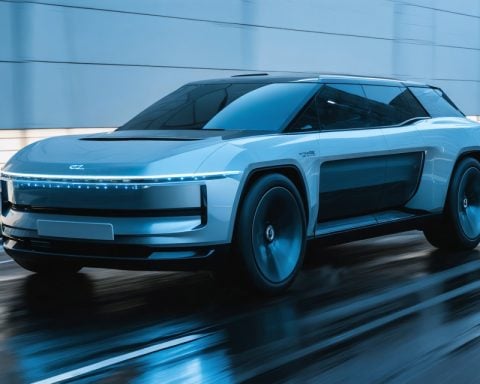- UBE Corporation is launching a groundbreaking plant in New Orleans dedicated to producing critical components for EV batteries.
- The facility will manufacture dimethyl carbonate (DMC) and ethyl methyl carbonate (EMC), pivotal for lithium-ion battery production.
- HYCO1 partners with UBE, introducing its CUBE™ Technology, which uses CO₂ efficiently and reduces emissions and costs.
- The innovative technology enhances production efficiency by delivering carbon monoxide (CO) and hydrogen (H₂) effectively.
- This initiative is seen as transformative for the EV industry, promoting greener energy solutions.
- New Orleans is set to become a hub for sustainable industry innovations with this new plant.
The sky in New Orleans painted a vivid backdrop as the air buzzed with anticipation at the groundbreaking event for UBE Corporation’s newest venture—a trailblazing plant dedicated to the production of critical components for electric vehicle (EV) batteries. Set against a backdrop of innovation and sustainability, this facility, heralded as a game-changer in the U.S., seeks to transform the landscape of lithium-ion battery production by crafting dimethyl carbonate (DMC) and ethyl methyl carbonate (EMC).
Amidst a gathering of industry titans and government dignitaries, the ceremony marked more than just the commencement of a construction project; it stood as a testament to a future driven by green energy. HYCO1, a leader in syngas production, proudly aligned with UBE to back this pioneering effort, bringing with it cutting-edge technology set to reshape battery manufacturing.
At the heart of this facility lies HYCO1’s revolutionary CUBE™ Technology. This innovation doesn’t merely cut costs; it paves the way for sustainable production by efficiently utilizing carbon dioxide (CO₂) as a feedstock, dramatically slashing emissions and operational expenses. The technology’s ability to deliver carbon monoxide (CO) and hydrogen (H₂) with unprecedented efficiency and resilience gives the plant a competitive edge in large-scale battery material production.
As this initiative barrels towards its future impact, it signals a monumental shift in battery technology, steering the electric vehicle market towards a greener horizon. New Orleans, soon home to this avant-garde plant, stands poised to be a beacon of sustainable industry innovation, echoing far beyond its city limits. This groundbreaking represents the dawn of a new era, where sustainability meets cutting-edge technology, redefining what’s possible in the world of EV batteries.
New Era of EV Battery Production: Game-Changing Technology and Sustainable Innovation
How-To Steps & Life Hacks
1. Understanding Battery Components:
– Learn about DMC and EMC as crucial electrolytes in lithium-ion batteries. They enhance battery performance, improve energy density, and ensure safety. Familiarize yourself with these materials to understand next-gen battery development.
2. Investing in Sustainability:
– Look into companies like UBE Corporation and HYCO1 to explore green technologies. Consider investments in sustainable ventures that align with environmental, social, and governance (ESG) criteria.
3. Embracing Carbon Utilization:
– Consider how industries can repurpose CO₂ and other waste gases using HYCO1’s CUBE™ Technology. Advocate for similar sustainable practices in organizations.
Real-World Use Cases
– Transportation:
– Transform national transit systems using buses and taxis powered by advanced lithium-ion batteries. Explore partnerships between municipalities and battery producers to upgrade fleets with sustainable options.
– Consumer Electronics:
– Apply improved battery technologies in gadgets, enhancing devices like smartphones and laptops with longer lifespans and faster charging.
– Renewable Energy Storage:
– Deploy these advanced batteries in solar and wind storage solutions, optimizing energy usage and ensuring reliability during peak demand.
Market Forecasts & Industry Trends
The global lithium-ion battery market is projected to grow to $135 billion by 2031, driven by increased EV adoption and demand for energy storage solutions. Key trends include the shift towards sustainable production, widespread EV integration, and automation in battery manufacturing processes.
Reviews & Comparisons
– UBE Corporation vs. Competitors:
– UBE’s focus on environmentally-friendly processes distinguishes it from other battery component manufacturers. Its partnership with HYCO1 exemplifies its leadership in innovative sustainable technologies.
Controversies & Limitations
– Environmental Impact:
– While new technologies reduce emissions, concerns remain regarding mining practices for raw materials like lithium. Ensuring ethical sourcing is paramount.
– Technology Implementation:
– High initial costs and potential technology integration challenges exist, though long-term benefits are compelling for industry adoption.
Features, Specs & Pricing
– CUBE™ Technology Features:
– The ability to convert CO₂ into valuable feedstock materials like CO and H₂ efficiently.
– Reduced carbon footprint and operational expenses.
– Pricing:
– Initial costs may vary, but the technology aims to reduce overall production costs, making it economically viable long-term.
Security & Sustainability
– Security:
– CUBE™ Technology ensures secure production with minimal environmental impact, aligning with modern regulatory standards.
– Sustainability:
– Contributes to achieving net-zero emissions targets, supporting global sustainability goals.
Insights & Predictions
– Expect increased adoption of CO₂ utilization technologies in various industries. This trend will likely accelerate as companies commit to reducing their carbon footprint and enhancing sustainability.
Tutorials & Compatibility
– Integration Tutorial:
– Detailed guidance for integrating CUBE™ Technology into existing battery manufacturing systems will be essential for seamless adaptation.
– Compatibility:
– Ensure alignment of current manufacturing processes with new technology requirements to maximize benefits.
Pros & Cons Overview
Pros:
– Environmentally sustainable
– Cost-effective in the long term
– Pioneering technology offering competitive advantage
Cons:
– Initial setup and integration costs
– Potential supply chain challenges for battery materials
Recommendations
1. For Innovators:
– Explore partnerships with companies like HYCO1 to leverage sustainable technologies in your operations.
2. For Investors:
– Evaluate the growth potential of companies investing in green technologies and EV battery production.
3. For Policymakers:
– Support initiatives and incentives that promote sustainable industries and technologies in your region.
4. For Educators:
– Integrate the study of innovations like CUBE™ Technology into academic programs to prepare students for future industry trends.
For more information on cutting-edge battery technology, visit the UBE Corporation website.



















